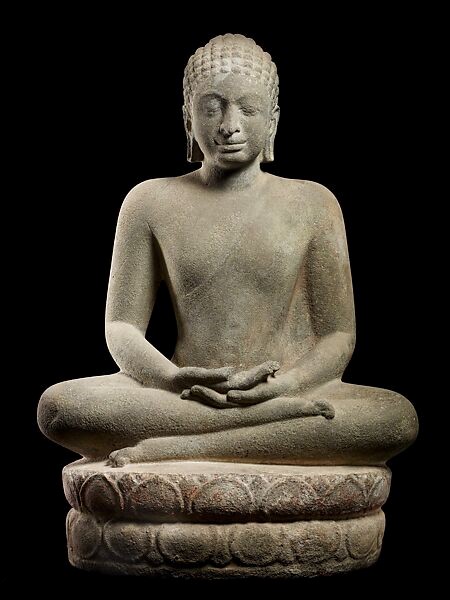Introduction
Definition of Mudras
Mudras are symbolic hand gestures used in different spiritual and cultural traditions, particularly in Buddhism, Hinduism and Jainism. Each mudra has a specific meaning and purpose, representing different aspects of spiritual teachings or states of mind. In Buddhist practice, mudras are often used during meditation, rituals, and in the representation of deities and enlightened beings.
Buddha statues in India:

Importance of Mudras in Buddhist Iconography
Mudras play a important role in Buddhist iconography as they help communicate the essence of teachings and the attributes of the Buddha and other figures. Each gesture represents deep meanings, such as compassion, wisdom, and protection.
For instance, the Dhyana Mudra signifies meditation and concentration, while the Abhaya Mudra represents fearlessness and reassurance. These gestures enhance the viewer’s understanding and emotional connection to the figures depicted, serving as a visual language that represent complex philosophical concepts.
Brief History of Buddha Statues and Their Use of Mudras
The history of Buddha statues dates back to the early centuries of the Common Era, evolving significantly as Buddhism spread across Asia. Initially, representations of the Buddha were symbolic, often avoiding human forms. However, by the 1st century CE, the Gandhara and Mathura schools began creating lifelike sculptures.
These statues frequently incorporate mudras to convey specific teachings or attributes of the Buddha.
As Buddhist art developed, regional variations appeared, each with unique styles and interpretations of mudras. In Mahayana Buddhism, for example, the incorporation of mudras became increasingly intricate, enriching the visual and spiritual experience.
Today, these statues and their mudras remain vital in teaching and preserving Buddhist philosophy, inspiring practitioners and appreciators too.
Understanding Mudras
What are Mudras?
Mudras are symbolic hand gestures used in spiritual and religious practices, they are believed to channel energy and convey specific meanings or intentions.
The Role of Hand Gestures in Buddhist Teachings
In Buddhism, mudras are an integral part of the teachings and practices. They serve as visual aids to represent different concepts, states of mind, and spiritual qualities.
For example, the abhaya mudra (fearlessness mudra) is often used to symbolize protection and reassurance, while the vitarka mudra (teaching mudra) is associated with wisdom and enlightenment.
Connection Between Mudras and Spiritual Concepts
The connection between mudras and spiritual concepts is deep-rooted. Each mudra is believed to activate specific energy centres in the body and mind, leading to various spiritual benefits. By practicing mudras, individuals can cultivate mindfulness, concentration, and inner peace.
some examples of mudras and their associated spiritual concepts:
- Anjali Mudra (Salutation Mudra): This mudra is often used as a greeting or a gesture of reverence. It symbolizes unity, peace, and respect.
- Chin Mudra (Chin Mudra): This mudra is believed to stimulate the mind and enhance concentration. It is often used in meditation practices.
- Dhyana Mudra (Meditation Mudra): This mudra is commonly used in meditation and represents a state of deep contemplation and enlightenment.
- Vajra Mudra (Thunderbolt Mudra): This mudra is associated with strength, power, and spiritual awakening. It is often used in Tantric Buddhism.
Major Mudras in Buddha Statues
Abhaya Mudra (Gesture of Fearlessness)
Overview of Abhaya Mudra: The right hand is raised with the palm facing outward.
(Seated Buddha from Gandhara, 1st-2nd century CE, Gandharan art, The Metropolitan Museum of Art.)
Spiritual Significance: Symbolizes fearlessness, protection, and reassurance. It is often depicted in Buddha statues to convey a sense of security and confidence.
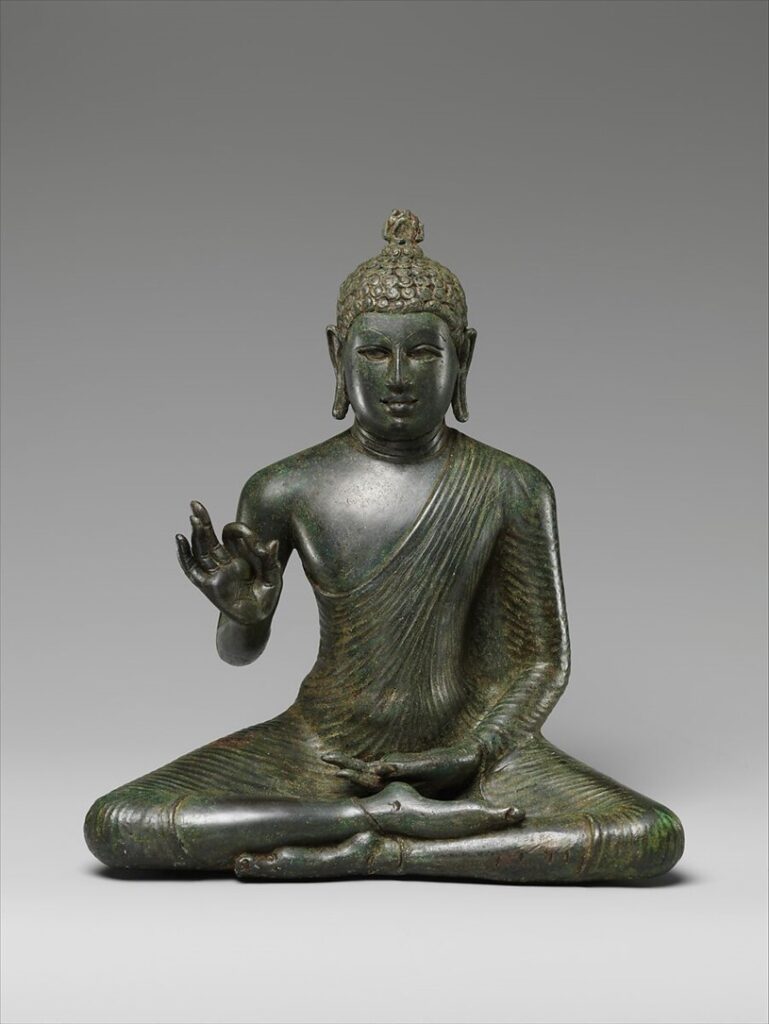
Common Depictions in Buddhist Art: The Abhaya Mudra is one of the most common mudras found in Buddhist art, especially in statues of the Buddha. It is often accompanied by the Vitarka Mudra (teaching mudra) in the left hand.
Bhumi Sparsha Mudra (Earth-Touching Gesture)
(Seated Buddha from China, Northern Song dynasty, 10th-11th century, Chinese art, The Metropolitan Museum of Art.)
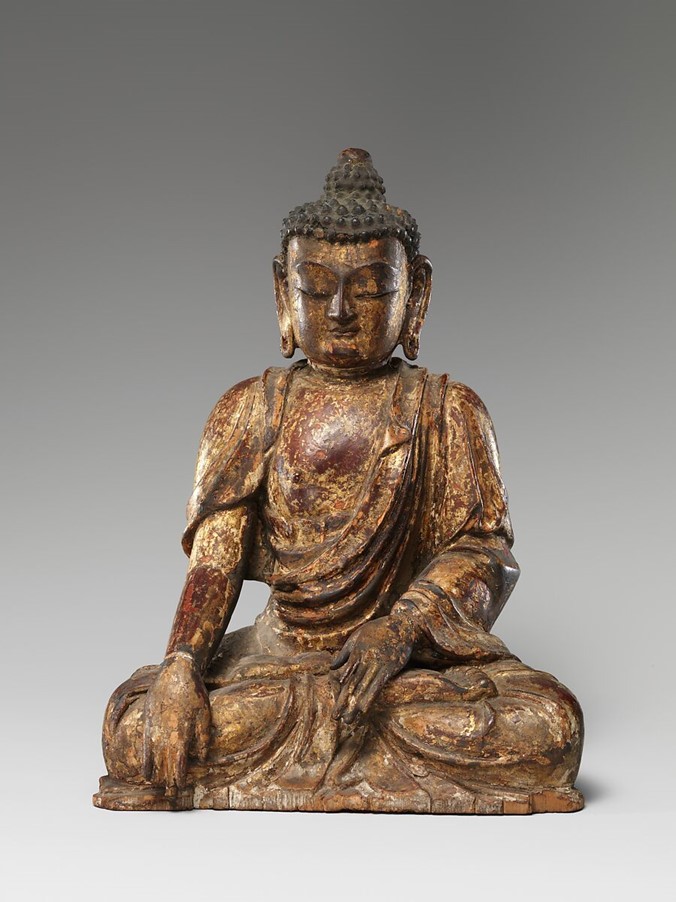
Overview of Bhumi Sparsha Mudra: The right hand is lowered to touch the ground with the fingertips.
Spiritual Significance: Represents the Buddha’s moment of enlightenment, when he called upon the Earth to witness his triumph over Mara, the tempter.
Association with the Moment of Enlightenment: This mudra is closely associated with the Buddha’s enlightenment under the Bodhi tree. It signifies his victory over temptation and his attainment of supreme wisdom.
Dharmachakra Mudra (Wheel of Dharma Gesture)
Overview of Dharmachakra Mudra: The right hand is raised with the palm facing outward, and the index finger and thumb touch, forming a circle. The left hand is placed in the lap with the palm facing upward.
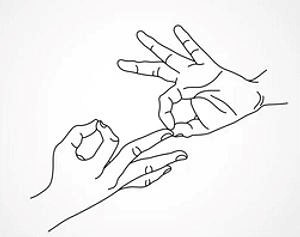
Spiritual Significance: Symbolizes the Buddha’s first sermon, in which he set forth the Four Noble Truths and the Eightfold Path. The circle represents the turning of the Wheel of Dharma, signifying the beginning of the Buddhist teachings.
Symbolism of the First Sermon: This mudra is a powerful symbol of the Buddha’s teachings and the path to enlightenment. It represents the transmission of wisdom, and the guidance offered to all beings.
Varada Mudra (Gift-Giving Gesture)
(Seated Buddha from Nepal, 12th century, Nepalese art, The Metropolitan Museum of Art.)
Overview: The right hand is extended with the palm facing outward, and the fingers are slightly curled.
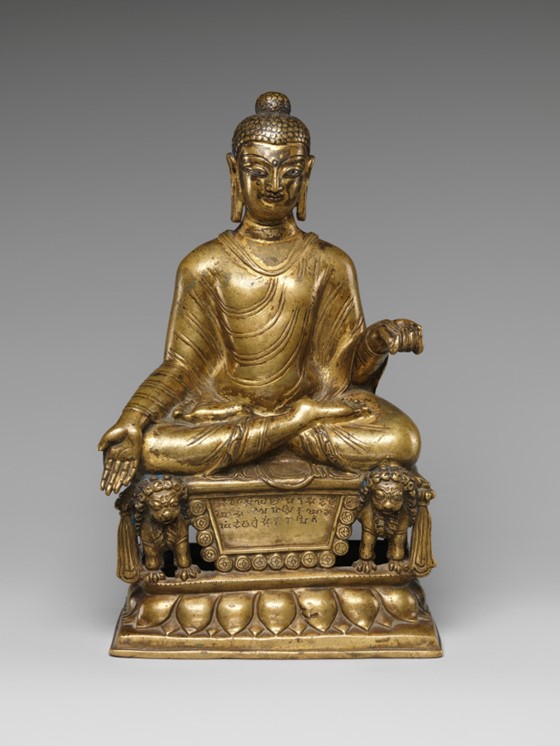
Spiritual Significance: Symbolizes compassion, generosity, and the offering of spiritual gifts. It is often depicted in statues of the Buddha or Bodhisattvas.
Connection to Compassion and Charity: The Varada Mudra is closely associated with the Buddha’s compassionate nature and his desire to help all beings. It represents the offering of guidance, protection, and spiritual blessings.
Less Common Mudras
Vitarka Mudra (Teaching Gesture)
(Seated Buddha from Central India, 9th-10th century, Central Indian art, The Metropolitan Museum of Art.)
Overview: The right hand is raised with the thumb and index finger touching, while the other fingers are extended. The Vitarka Mudra is often paired with the Abhaya Mudra (fearlessness mudra) in statues of the Buddha. It is also used in depictions of the Buddha’s first sermon.
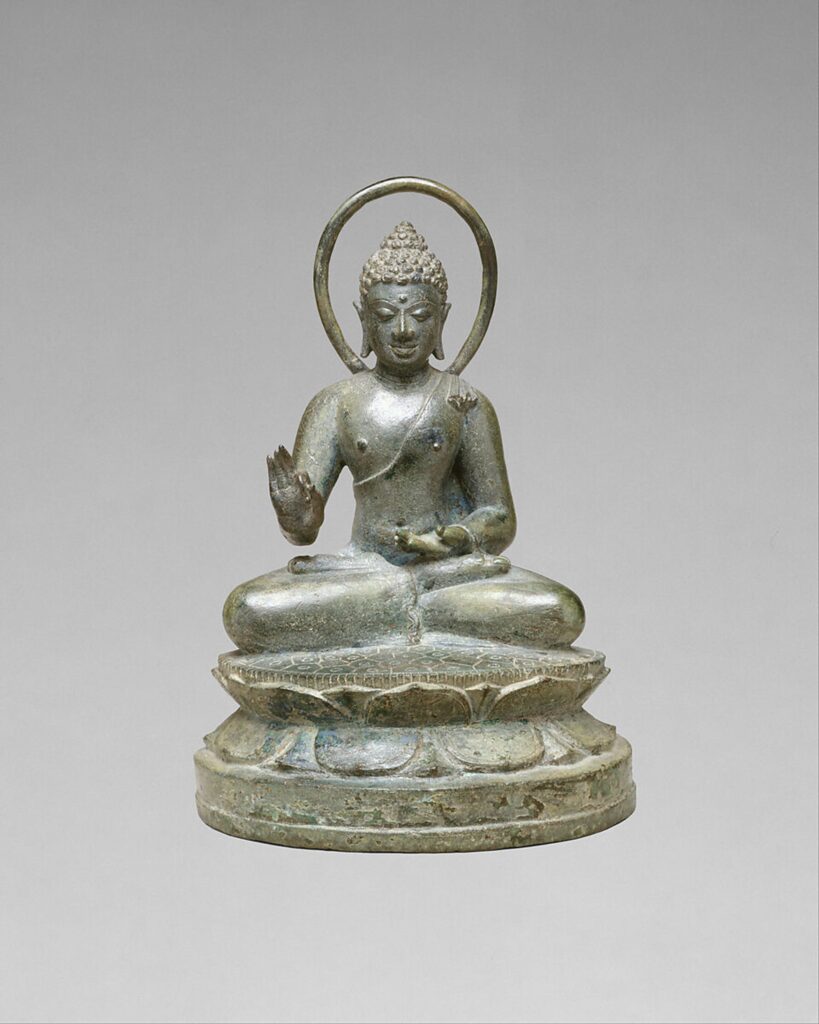
Spiritual Significance: Symbolizes teaching, preaching, and the transmission of knowledge.
Anjali Mudra (Gesture of Greeting)
Overview: Both hands are brought together in front of the chest, palms pressed together.
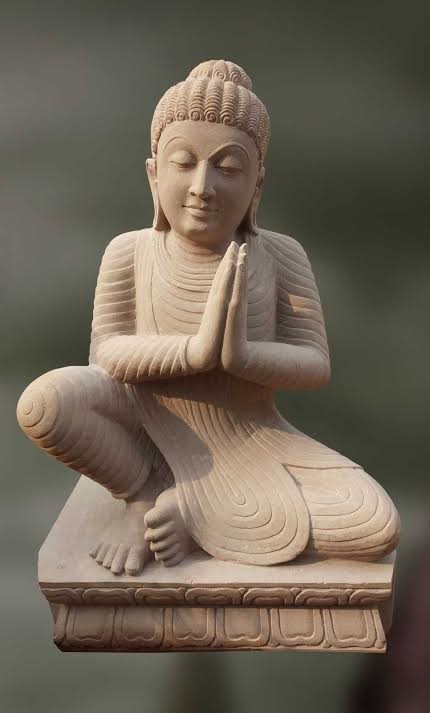
Spiritual Significance: Symbolizes respect, reverence, and greeting. It is often used as a gesture of salutation or devotion.
Karana Mudra (Warding Off Evil Gesture)
Overview: The right hand is raised with the palm facing outward, and the index finger is pointed upward.

Spiritual Significance: Symbolizes the warding off of evil, danger, or negative influences. It is often depicted in statues of the Buddha or Bodhisattvas protecting beings from harm.
Regional Variations in Mudras
Differences Between Theravada, Mahayana, and Vajrayana Traditions
- Theravada Buddhism: Theravada Buddhism primarily focuses on the historical Buddha and his teachings. Mudras used in Theravada are often simpler and more traditional, emphasizing the Buddha’s teachings and the path to enlightenment.
- Mahayana Buddhism: Mahayana Buddhism emphasizes the Bodhisattva path, where enlightened beings vow to save all beings. Mudras used in Mahayana are more diverse and often depict Bodhisattvas and their specific attributes.
- Vajrayana Buddhism: Vajrayana Buddhism is a tantric form of Buddhism that emphasizes the use of ritual practices and symbols. Mudras in Vajrayana are often more complex and symbolic, representing various deities, tantric practices, and spiritual concepts.
Geographical Variations
mudras are a significant aspect of Buddhist iconography, conveying a wealth of information about the Buddha, Bodhisattvas, and their teachings. While there are common mudras used across different Buddhist traditions, regional variations and cultural influences have shaped the development and use of mudras in various parts of the world.
Interpreting Mudras in Buddhist Art
How to Identify Mudras in Statues and Paintings
To identify mudras in Buddhist art, pay attention to the position and orientation of the hands. The specific arrangement of the fingers and palms can provide clues to the mudra being depicted.
Here are some tips for identifying mudras:
Hand Position: Look at the overall position of the hands. Are they raised, lowered, or resting on the lap?
Finger Arrangement: Examine the arrangement of the fingers. Are they extended, curled, or touching each other?
Palm Orientation: Note the direction the palms are facing. Are they facing inward, outward, or upward?
The Interplay Between Mudras and Other Iconographic Elements
Mudras are often used in conjunction with other iconographic elements to convey a more complete meaning. These elements can include: Facial Expressions, Attributes, and Posture.
The Role of Mudras in Buddhist Worship and Meditation
Mudras play a significant role in Buddhist worship and meditation practices. By practicing mudras, individuals can connect with the spiritual energy associated with the particular mudra and cultivate specific qualities, such as mindfulness, compassion, or wisdom.
In Buddhist temples and monasteries, mudras are often used during rituals, prayers, and meditation sessions. Devotees may perform mudras individually or collectively, as a way to connect with the Buddha or Bodhisattvas and receive their blessings.
Modern Relevance of Buddha Mudras
Use of Mudras in Contemporary Buddhist Practice
Mudras continue to be an important part of contemporary Buddhist practice, serving as a way to connect with the Buddha’s teachings and cultivate spiritual qualities. Many Buddhist practitioners incorporate mudras into their daily meditation, prayer, and ritual practices.
Influence on Yoga and Mindfulness Practices
The concept of mudras has also influenced yoga and mindfulness practices, particularly in the West. Many yoga practices incorporate hand gestures that are similar to Buddhist mudras, such as the Anjali Mudra (salutation mudra) and the Chin Mudra (chin mudra). These mudras are believed to have a positive impact on physical and mental well-being, helping to improve balance, flexibility, and concentration.
Artistic Interpretations in Modern Sculptures and Paintings
Buddhist mudras continue to inspire artists and sculptors, who often incorporate them into their work. Modern interpretations of Buddhist mudras can range from traditional depictions to abstract or contemporary expressions.
These artistic interpretations can help to bridge the gap between ancient Buddhist traditions and modern culture, making the concept of mudras accessible to a wider audience.
Conclusion
The Enduring Significance of Mudras in Buddhist Spirituality
Mudras remain an enduring symbol of Buddhist spirituality, providing a visual language that transcends cultural and linguistic barriers. They serve as a powerful tool for connecting with the Buddha’s teachings, cultivating spiritual qualities, and fostering a sense of inner peace.
The Universal Language of Hand Gestures in Religious Iconography
Beyond Buddhism, hand gestures are used in various religious traditions as a form of symbolic communication. This universal language of hand gestures highlights the shared human experience of spirituality and the interconnectedness of different cultures.
Invitation for Readers to Observe and Reflect on Mudras in Buddhist Art
I invite readers to observe and reflect on the mudras depicted in Buddhist art. By understanding the meaning and symbolism behind these hand gestures, we can gain a deeper appreciation for the rich and diverse traditions of Buddhism.
Whether you are a practicing Buddhist or simply curious about the world of art and spirituality, exploring the world of mudras can be a rewarding and enlightening experience.
